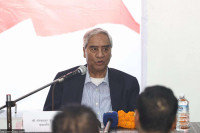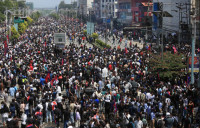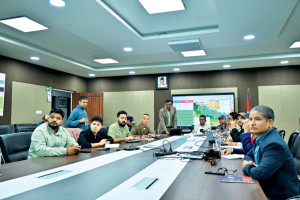Opinion
Judge them well
The Judicial Council must balance seniority, experience, and capability while nominating judges
Krishna Man Pradhan
The strategic plan of the Supreme Court has four clear objectives—to make the judiciary accessible, predictable, efficient, and trustworthy. These objectives were laid down in the first five-year plan, in 2005. Even as the court is currently implementing the third such plan, its goals have not yet been fulfilled. There are many reasons for this. However, this article will deal only with the human resource at the very top.
Currently, the Supreme Court has 12 permanent judges. The Interim Constitution stipulates there should be 15 such permanent judges, apart from a number of other temporary judges who should be appointed as per the need. And the need is clearly present. The annual report of the Supreme Court states that there are 76,148 cases pending in various courts all over the country. In the Supreme Court alone, there are 18,789 cases pending. One of the reasons for this great backlog is the lack of judges at the apex court.
The current council
The Judicial Council (JC) is entrusted with managing and appointing human resources in the judiciary, including the apex court. On the one hand, Nepal’s JC has attracted lot of praise since its inception back in 1990 as a truly independent body that strengthens judicial independence by preventing any kind of executive or legislative intervention in the matters of appointment, transfer, or management of judges at the courts. On the other hand, of late, its appointment and actions have drawn a lot of criticism. For instance, when it nominated eight judges to the Supreme Court a year ago, it was criticised for making seniority the only criteria for selection, without giving due consideration to capability or performance. But when it nominated Appellate Court judges a year and a half ago, it was criticised for overlooking seniority and capability and resorting to what many called a ‘pick-and-choose’ style.
As laid out in the Interim Constitution, the Judicial Council has five members—the Chief Justice (chair), the senior-most judge at the Supreme Court, the justice minister, a nominee of the prime minister, and a nominee of the Nepal Bar Association. At present, the composition of the Judicial Council is as such—Chief Justice Ram Kumar Prasad Shah, Justice Minister Narahari Acharya, senior judge Kalyan Shrestha, and the prime
minister’s nominee Khem Narayan Dhungana. The fifth member, who was the nominee of the Bar Association, Upendra Keshari Neupane, resigned three months ago after the Bar Association wrote a letter demanding his withdrawal. The Bar was unhappy with the way the Council had overlooked its concerns during last year’s appointment of Supreme Court judges. Since the chief justice is retiring in a couple of months and Dhungana is also retiring next month, the Council itself will lack members.
This comes at a time when the Council is expected to nominate not only Supreme Court judges but also fill up scores of district and appellate court postings. This is, therefore, the right time to discuss challenges before the Judicial Council and how they can be overcome.
On performance
Due to the lack of a clearly stipulated protocol or guideline, all of the JC’s nominations or actions draw criticisms from one quarter or the other. After the resignation of the Bar nominee, the Supreme Court has written to the Bar asking it to nominate a replacement. However, the Bar has been unable to choose a replacement because of conflicting views within it. This has resulted in a situation whereby the Council will either need to wait for the Bar’s nominee or take decisions without the full council. Though the constitution does not say anything about how the absence of one or two members will affect its decision-making process, the practice has been that the Council takes decisions by consensus.
This problem has resulted in a sense of anxiety and even frustration among the larger community of judges at the district and appellate court levels. They are demoralised that their performance is not being appraised very well. The Secretariat of Council keeps records of the individual profile of all judges. But the JC never seems to study it carefully while making nominations or taking actions. In fact, from the time of the implementation of the Interim Constitution, the Council has not taken action against even a single individual based on performance or allegations of corruption. A further challenge is ensuring that nominations are inclusive. At present, less than five percent of the total judges are women or Dalit or Muslim or Janajati.
Rebuilding trust
The first thing is to build trust among Council members by regularly holding meetings. The chief justice should take leadership, put forward an agenda, and try to win the confidence of others. The Council needs to study the profiles prepared by the Secretariat, match it with a similar record kept by the apex court, and only then take decisions.
At present, the Council is also incomplete. The Supreme Court must urge the Bar to nominate its member at the soonest, perhaps within a week. The Council should not wait forever. If there is no nomination, it should start taking decisions based on two-thirds majority.
One of the key needs at present is also the need to build confidence between the bar and the bench. One way of doing so could be fair nominations by the Council for vacant positions in the apex court. If the Council makes a decision to nominate three permanent judges and seven temporary judges for the apex court, it can implement the formula of 60-40 by nominating 60 percent from among cadre judges and 40 percent from the lawyers’ community. If the JC does so without compromising on seniority, performance, and track record, it will boost its confidence. In fact, when selecting nominees from the lawyers’ community, the Council should give due consideration to expertise, experience, and integrity.
Likewise, in order to address growing questions about corruption and capability, the Council itself should form a committee to study the situation and provide recommendations within three months, which should then be implemented. If these matters are properly addressed, it will mark the beginning of the turnaround of the judiciary. It will also help stem questions raised in some srs about the very necessity of this council in its present form.
Pradhan is an Executive Director of the Nepal Law Society




 22.12°C Kathmandu
22.12°C Kathmandu










